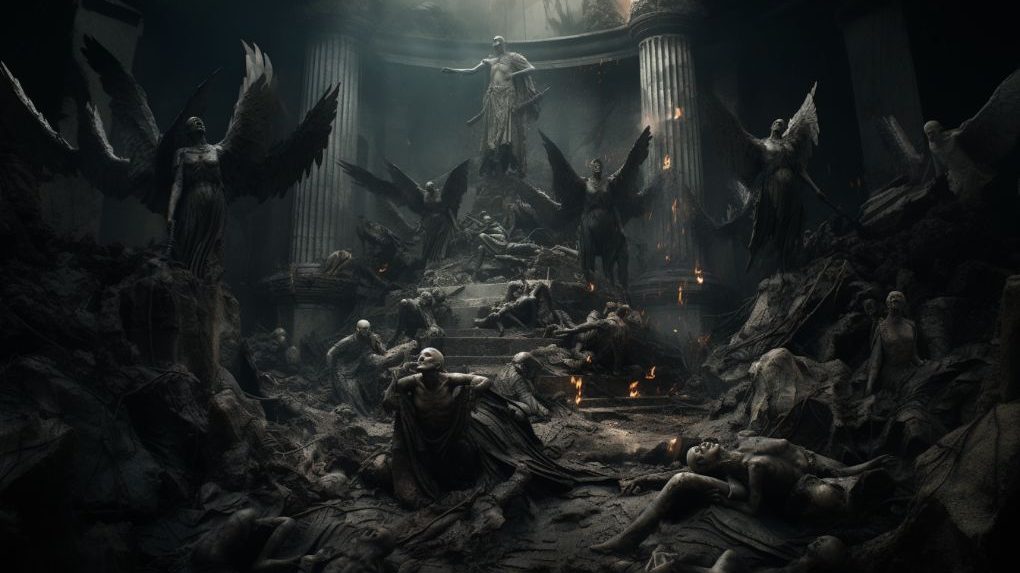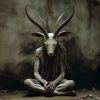In the vast, uncharted landscapes of the unseen world, the concept of “demons,” often represented as the ultimate embodiments of malevolence and wrongdoing, holds a unique allure.
An integral part of many cultural narratives and religious traditions, these entities trigger a deep fascination and a gripping fear. As enigmatic as they are intriguing, their depiction spans across the spectrum—from grotesque, fear-inspiring creatures to cunning, deceptive beings. Yet, one question reverberates through history and belief: How many demons are there? This exploration embarks on a journey through the mysterious realm of demons and evil spirits, drawing insights from various theological and cultural perspectives and ultimately attempting to unearth the elusive answer.
Unraveling the Concept of Demons
The concept of demons, fascinating and perplexing, often takes center stage in the tableau of supernatural entities. Frequently associated with darkness and evil, these beings are interpreted and depicted in myriad ways across various cultures, religions, and belief systems. The understanding of demons dates back to antiquity, with each historical period contributing unique perspectives and narratives to their ever-evolving portrayal.
Demons in Christian Belief
Demons are considered fallen angels in the Christian worldview, steeped in biblical teachings. According to Christian demonology, these celestial beings were cast out of heaven following their rebellion against God, led by Lucifer, now known as Satan or the Devil. This heavenly revolt resulted in their transformation from divine entities of light into evil beings associated with darkness and evil.
This narrative, derived from biblical passages, paints demons as evil entities. Their primary objective is to disrupt the natural order, create chaos, and lead humans away from the path of righteousness. They strive to sow seeds of doubt, exploit human weaknesses, and incite individuals to commit sins. This notion is deeply ingrained in Christian theology, influencing moral teachings, spiritual practices, and interpretations of worldly events.
Jewish Demonology: A Different Perspective
Contrasting the Christian view, Jewish demonology offers a somewhat different portrayal of these entities. With its rich tapestry of supernatural tales, Jewish folklore introduces an array of demonic creatures, each with unique attributes and roles.
As depicted in Jewish literature and mythology, these demons can influence human affairs in various ways. They are often associated with specific sins, illnesses, or misfortunes, serving as supernatural explanations for various worldly occurrences.
In “Legends of the Jews” by Louis Ginzberg, readers are offered diverse demonic narratives. These stories depict demons as beings with considerable power capable of causing harm and mischief. A recurrent history is that of the child-stealing demon, a theme also prevalent in tales narrated by old women to enforce obedience among children.
These different cultural depictions underscore the complexity of the demonic concept. They highlight how cultural contexts, religious beliefs, and societal norms shape our understanding of these enigmatic entities. Demons, whether viewed as literal beings or symbolic representations, continue to captivate our collective imagination, serving as a mirror to our fears, struggles, and moral dilemmas.
Unraveling the Demonic Count: Christian Perspectives
As stated earlier, Christian demonology doesn’t provide a precise number of demons. However, specific passages from religious texts, like the Bible, and interpretations by scholars give an impression of their abundance.
One such account occurs in the Book of Revelation, which describes a dramatic war in heaven between angels. In this war, it’s said that the dragon (interpreted as Satan or the Devil) swept a third of the stars (interpreted as angels) out of the sky, casting them down to earth. If these fallen angels are considered demons and given the often-quoted figure of a heavenly host of ten thousand times ten thousand angels, one could infer the existence of many demons.
Further interpretations are found in literature, such as John Bunyan’s “The Pilgrim’s Progress.” This allegorical novel describes a spiritual journey where the protagonist encounters many demons and other representations of evil, reinforcing the notion of a world filled with these evil entities.
Quantifying the Innumerable: Hindu Perspectives
The question, “How many demons are there?” assumes a different form in Hindu mythology. Here, the forces of evil or ‘asuras’ are not necessarily equivalent to the Western concept of demons, but they perform a similar role of embodying vice and ignorance.
Hindu scriptures, notably the Puranas and the epics like Mahabharata and Ramayana, often depict battles between deities and asuras, where the latter usually represent moral and spiritual darkness. These texts mention different demons or asuras by name, each associated with a particular vice or negative trait.
Although some may interpret the specific names as suggesting a limited number of asuras, the general understanding is that these beings are essentially countless. This belief is reinforced by the concept of reincarnation and the cyclic nature of time in Hinduism, where these asuras are reborn in every cosmic cycle to maintain the balance between good and evil.
Demonic Count in Other Religions and Mythologies
The number of demons or analogous entities in other religions and mythologies also varies, further complicating determining a definitive count. For instance, in Jewish folklore and Kabbalistic demonology, the number of demons is often said to be countless, mirroring the sand on the seashore or the dust of the earth.
Greek mythology offers a slightly different perspective. While not demons in the Christian sense, entities like the daemons could be benevolent or malevolent and were believed to be innumerable. They represented various natural forces, human emotions, and states of the human condition, hence the vast number.
Like Christianity, Islamic tradition views demons (or ‘jinn’) as a separate creation from humans and angels. The Quran and Hadith literature suggest the existence of many jinn, although no exact number is given.
Scholarly Interpretations on the Demonic Count
Numerous scholars have attempted to theorize the number of demons. These interpretations often reflect the scholars’ theological perspective, cultural context, and personal beliefs. Some, like the medieval theologian Thomas Aquinas, suggested that the number of demons (fallen angels) would be vast, as they were part of an initial creation of angels, many of whom lost.
Modern scholars may approach this question from a psychological, sociological, or anthropological standpoint. Carl Jung, the influential psychologist, proposed that these entities might represent aspects of the collective unconscious, which could potentially suggest countless demons, given the vast range of human experiences and emotions.
In conclusion, the exact number of demons remains elusive, wrapped in layers of interpretation, personal beliefs, and cultural context. While it’s tempting to seek a specific count, the focus could instead be on understanding what these numerous demons represent in various cultures, religions, and personal beliefs, shedding light on our shared fears, moral struggles, and attempts to comprehend the unknown.
A Panorama of Demonic Entities: Known Demons Across Cultures
Throughout the tapestry of human civilization, countless demonic entities have found their way into cultural narratives, religious texts, and folklore. Here is an exploration of some of the most well-known demons across different cultures and belief systems.
Lucifer: The Fallen Angel
Lucifer is a central figure in Christian demonology, often identified with Satan, the Devil. He was initially one of God’s most beautiful angels associated with light. However, he rebelled against God and was subsequently cast out of heaven. Following this fall, Lucifer, or Satan, became a symbol of ultimate evil and temptation, continuously striving to lead humans away from the path of righteousness.
Lilith: The First Demon
In Jewish folklore, Lilith is often depicted as the first demon. As per some legends, she was Adam’s first wife, created simultaneously and from the same earth as Adam. However, she rebelled against Adam’s dominance and left the Garden of Eden, transforming into a demon. Lilith is often associated with child mortality and is said to steal newborns at night.
Mara: The Tempter
In Buddhist mythology, Mara is the demon who tempted Prince Siddhartha (Gautama Buddha) on his path to enlightenment. Symbolizing desire and death, Mara attempts to distract Siddhartha with visions of beautiful women and instill fear in him through terrifying scenes. Despite his efforts, Siddhartha remained unmoved and reached enlightenment, becoming the Buddha.
Asmodeus: The Demon of Lust
Asmodeus is a demon who finds mention in Christian and Jewish demonology. He is often associated with the sin of lust. Asmodeus is portrayed in the deuterocanonical Book of Tobit, where he kills the husbands of a woman named Sarah on their wedding night until the angel Raphael intervenes.
Ravana: The Ten-Headed Demon King
In Hindu mythology, Ravana is a ten-headed demon king, the primary antagonist in the epic Ramayana. Despite his demonic nature, Ravana is a complex character renowned for his knowledge, devotion to Lord Shiva, and prowess in battle. His abduction of Sita, the wife of the hero Rama, sets the stage for the epic battle that ultimately leads to his downfall.
Paimon: The Artistic Demon
Paimon is a demon mentioned in multiple grimoires, including the Lesser Key of Solomon. He is known for his obedient nature to Lucifer and holds the rank of a king in hell. Paimon is said to have the power to bestow knowledge on various topics, especially the arts, and to control and manipulate others will.
Beelzebub: Lord of the Flies
Originating from the Philistine religion and later incorporated into Christian and Jewish demonology, Beelzebub is often depicted as one of the chief demons. His name, translating to ‘Lord of the Flies’, reflects his association with decay and corruption. In the New Testament, some Pharisees accuse Jesus of driving out demons by the power of Beelzebub.
Azazel: The Scapegoat
Azazel is a demon mentioned in Jewish and Christian texts. In the Book of Leviticus, a goat is sent into the wilderness to Azazel as part of the Day of Atonement ritual, symbolically carrying away the community’s sins. In the apocryphal Book of Enoch, Azazel is a fallen angel who teaches humans forbidden knowledge.
Kali: The Destructive Force
In Hindu mythology, Kali is a complex figure who, while not strictly a demon, embodies aspects of destruction and chaos. She is portrayed as a dark-skinned goddess with a fearsome appearance, often standing on the body of her consort, Shiva. Despite her terrifying demeanor, Kali symbolizes time, change, and protection against evil.
Ahriman: The Destructive Spirit
In Zoroastrianism, Ahriman (or Angra Mainyu) is the destructive spirit and the chief adversary of Ahura Mazda, the supreme deity. Ahriman represents darkness, falsehood, and evil, directly opposing the principles of order and truth upheld by Ahura Mazda.
Belphegor: The Demon of Sloth
Belphegor is a demon recognized in Christian demonology, associated with one of the seven deadly sins: sloth. He tempts people by suggesting ingenious inventions to make them rich, promoting laziness and rationalized justification for their sins.
Each demon carries a rich narrative tapestry woven through centuries of lore, legend, and belief. These entities, as complex as the cultures they emerge from, continue to offer insight into human fears, vices, and moral struggles.
Classifying Demons: The Hierarchies of Hell
While the classification of demons may seem somewhat arbitrary, certain patterns emerge in various religious and cultural traditions. The hierarchy of these entities often varies based on their power, influence, and associated vices.
The Christian Hierarchical Model
One common theme in Christian demonology is the classification based on the seven deadly sins. Each sin is personified by a specific demon, culminating in a list of seven principal demons. This idea is most vividly depicted in Dante Alighieri’s “Inferno,” part of his epic “Divine Comedy,” where Hell is divided into circles, each associated with a deadly sin and its corresponding demon.
In Christian tradition, these principal demons, sometimes referred to as “princes of Hell,” include Lucifer (Pride), Mammon (Greed), Asmodeus (Lust), Leviathan (Envy), Beelzebub (Gluttony), Satan (Wrath), and Belphegor (Sloth). They sit atop a demonic hierarchy, ruling over lesser demons. Each represents a different aspect of human moral shortcomings and is a stark reminder of spiritual consequences.
However, it’s crucial to note that this classification is not universal within the Christian tradition, and many variants exist. Some sources, for instance, list other demons, such as Belial and Moloch, among the princes of Hell, highlighting the lack of a singular, authoritative list.
Demonic Hierarchies in Other Cultures and Religions
Other cultures and religions also classify demons, although the categories can differ significantly. In Hindu mythology, for instance, asuras (analogous to demons) are not typically divided into classes based on sins. Instead, their deeds and characteristics often distinguish them in various mythological narratives.
Similarly, Islamic tradition divides the jinn (often equated with demons) into classes based on their abilities and characteristics. Some can shape-shift, others have wings and can fly, while others resemble animals or monstrous beings.
In sum, while the classification of demons can differ across various religious and cultural traditions, many agree on the existence of a hierarchy, ranging from lesser demons to more powerful entities.
Evil Spirits: Demons by Another Name?
The term “evil spirits” often surfaces in discussions about demons, leading to questions about the relationship between these entities. Are they synonymous, or do they represent distinct categories of supernatural beings?
“evil spirits” and “demons” are used interchangeably in many cultures and religions. They collectively refer to evil supernatural entities that influence or interfere with the human world. However, certain traditions distinguish between the two based on factors such as power, origin, or the type of influence they exert.
For instance, in some branches of Christian thought, all demons are considered evil spirits, but not all evil spirits are considered demons. Some may classify ghosts—the spirits of deceased humans—as a type of evil spirit distinct from demons, who are deemed fallen angels.
Moreover, some indigenous and shamanic traditions differentiate between evil spirits and demons based on their nature and purpose. Evil spirits might be the tormented souls of humans or natural spirits corrupted or angered, while demons represent a fundamentally different category of supernatural entities.
Despite these nuanced distinctions, it’s essential to note that the line between evil spirits and demons often remains blurred, and interpretations can vary widely based on individual beliefs, cultural contexts, and religious doctrines. As such, while it’s helpful to understand the different perspectives, the exact definitions of these entities remain elusive and open to interpretation.
Demonology Across Different Cultures
Demons manifest themselves in myriad ways across cultures. The Abrahamic religions—Judaism, Christianity, and Islam—exhibit a certain degree of commonality, primarily the notion of fallen angels. Conversely, Eastern religions, including Hinduism and Buddhism, depict these beings differently. Here, they symbolize moral failings, ignorance, or spiritual obstacles rather than the absolute evil represented in Abrahamic religions.
Tribal and indigenous cultures worldwide have unique interpretations of demonic entities. These beings serve as cautionary figures, elemental spirits that have been wronged, or representations of natural calamities. A comparative examination of these various perspectives presents a rich tapestry of beliefs and interpretations regarding the existence and multitude of demons.
Demons in Literature: From Classical Tales to Modern Narratives
The depiction of demons in literature plays a vital role in shaping our collective understanding of these entities. From ancient religious texts and classical literature to contemporary novels, the portrayal of these beings has evolved, reflecting societal changes and expanding our understanding of good and evil.
Modern Media and the Evolution of Demonic Representation
Contrastingly, modern literature and media have broadened the portrayal of demons. Movies, television series, novels, and comic books frequently depict demons in roles that go beyond the conventional definition of unmitigated evil. They often present these entities as complex characters with motivations and struggles, thereby humanizing them and bringing them closer to the human psyche.
This nuanced representation is evident in works such as the “Good Omens” novel by Neil Gaiman and Terry Pratchett and its subsequent TV adaptation. The book portrays a demon as one of the protagonists, challenging traditional perceptions of these entities.
Despite their fictional nature, these depictions contribute to our understanding of demons, adding complexity to these supernatural beings and reflecting societal shifts in our understanding of morality and the nature of evil.
Dealing with Demons: Protective Measures and Rituals
Beliefs about demons extend beyond the theoretical realm, significantly influencing human actions and societal norms. Various protective measures and rituals have been developed throughout history to ward off or counteract the perceived influence of these entities.
Exorcisms: The Christian Approach
Exorcism, a religious or spiritual practice of evicting demons or other spiritual entities from a person or place believed to be possessed, has been a central part of the Christian response to demonic possession. The New Testament, particularly the Gospels, contains several accounts of Jesus casting out evil spirits from individuals. These accounts have formed the basis for the Christian practice of exorcism as depicted in numerous films like “The Exorcist.”
Talismans and Amulets: Universal Symbols of Protection
Various cultures and religions use talismans and amulets to protect against demonic influences. These items, often inscribed with religious symbols or texts, are believed to possess the power to ward off evil spirits. For example, the ‘evil eye’ amulet, prevalent in many Mediterranean and Middle Eastern cultures, is widely used to shield against evil forces.
Incantations and Rituals: Cultural Practices to Counteract Demons
Many cultures practice specific rituals and incantations designed to neutralize or ward off demonic forces. These range from the complex exorcism rituals of the Catholic Church to the shamanistic practices of various indigenous cultures.
The practices developed to deal with demons highlight the tangible manifestation of collective fear and the inherent human desire to safeguard oneself from unseen dangers. They underline the profound influence of beliefs about demons on human behavior and cultural norms, demonstrating the impact of these entities on our understanding of the world.
Scholars and Demons: Divergent Views on Existence and Count
The existence and number of demons have been topics of considerable debate within academic circles. Opinions often diverge sharply, with views influenced by personal faith, interpretative readings of religious texts, and intellectual leanings.
Believers in the Countless Many
Many scholars, particularly those with strong religious convictions, argue for the existence of a countless multitude of demons. Their beliefs are often rooted in interpretations of sacred texts, historical accounts, and cultural folklore.
For example, Christian scholars might point to biblical passages hinting at a multitude of fallen angels who were cast down with Lucifer, now considered demons. Jewish scholars could reference Jewish demonology and Kabbalistic texts that suggest a complex spiritual hierarchy teeming with demonic entities.
These scholars often consider anecdotal accounts and experiences within their faith communities as further evidence of the existence of demons. Their understanding of the world incorporates these entities, often attributing specific events or conditions to their influence.
Skepticism and Rationalist Perspectives
In contrast, some scholars adopt a more skeptical or rationalist approach. They question the existence of demons as independent entities and often interpret them as symbolic or psychological constructs.
Many view demons as personifications of humanity’s collective fears, individual failings, or societal problems. For instance, the seven deadly sins, each associated with a specific demon, could be seen as an attempt to externalize internal struggles with vices.
Moreover, some scholars see the belief in demons as a means of explaining phenomena that were otherwise inexplicable in historical contexts, attributing diseases or natural disasters to demonic influence.
The Cultural Impact of Demonic Beliefs
Regardless of their stance on the actual existence of demons, scholars widely acknowledge the significant cultural and societal impact of beliefs surrounding these entities. They play a fundamental role in many world religions, shaping societal norms, moral codes, and rituals. They also serve as a fertile ground for artistic expression, influencing literature, film, and art.
Furthermore, these beliefs can have real-world consequences, informing attitudes toward mental health, crime, and punishment. Understanding the role of demons in cultural and societal contexts is thus an essential aspect of many scholarly disciplines, from theology and comparative religion to anthropology and psychology.
Whether viewed as literal beings or symbolic constructs, demons remain a compelling subject of study and debate within scholarly circles. Despite the divergent viewpoints, the multifaceted impact of these entities on human culture is undeniable.
Examining Demons in the Light of Modern Thought
In the current epoch, marked by a quest for rationality and scientific validation, the belief in demons might seem archaic to some. However, even the staunchest proponents of logic cannot entirely dismiss the influence of these ancient beliefs. Demons often find their way into contemporary discourse through metaphors or symbols. This is apparent in expressions like “battling one’s demons” or “inner demons,” signifying personal struggles, fears, or weaknesses.
Moreover, the concept of demons holds relevance in various disciplines, such as psychology, sociology, and cultural studies. For instance, psychologist Carl Jung’s theory of the ‘Shadow’—the dark, unconscious aspect of the personality—echoes the characteristics traditionally associated with demons. As such, these entities, viewed as literal beings or metaphorical constructs, continue to permeate our collective consciousness, shaping the narrative of good versus evil, right versus wrong.
Demons and the Human Condition
In a broader context, the belief in demons speaks volumes about the human condition and our understanding of morality. Demons often personify what societies deem unacceptable or sinful, serving as tangible reminders of moral boundaries and societal norms. As such, they play a pivotal role in shaping individual behavior and societal structures. They represent the dark side of human nature, the potential for evil inherent in every person. Recognizing and navigating this potential is a part of the human experience, an ongoing struggle toward moral integrity.
Moreover, the ambiguity surrounding the count of demons further underscores the complexity of the human moral landscape. If we conceive each demon as symbolizing a unique vice, the countless vices and moral failings possible within humans could suggest infinite demons.
Demons: A Unifying Concept across Cultures
While the specifics may vary, demonic entities are a unifying thread across cultures and religions worldwide. This universality hints at an underlying shared human experience—fear of the unknown, confrontation with evil, and the struggle between moral choices. Even atheistic and agnostic philosophies, which reject the literal existence of supernatural beings, acknowledge the symbolic significance of demons, recognizing their role in articulating moral and ethical dilemmas.
In essence, the world of demons, with its multitude of interpretations, offers a mirror reflecting our deepest fears, moral struggles, and the complexity of the human condition. So, the next time the question, “How many demons are there?” arises, perhaps the answer lies not in an exact number but in introspection of our fears and moral choices. As we continue to explore and understand these supernatural entities, we may also come closer to understanding ourselves and the world around us.
Conclusion: Reflections on How Many Demons There Are
Delving deeper into the analysis of how many demons there are, it becomes evident that the answer is highly subjective. It heavily depends on individual beliefs, cultural backgrounds, and interpretative lenses. From a literal standpoint, some may argue that there are as many demons as sins or negative human attributes. Each vice, each moral failing, could potentially have a demon associated with it.
Regardless of the interpretive stance, it is clear that the concept of demons and evil spirits continues to hold sway over the human imagination. Whether they serve as metaphoric representations of our inner demons, personifications of societal ills, or real beings influencing our lives, they remain deeply entrenched in our collective consciousness.
As such, our final thoughts might not provide an absolute number but rather a reflection of what these entities symbolize. Despite the evolution of society and advancements in scientific understanding, the age-old belief in demons persists. This enduring belief, transcending time and space, reflects the power of cultural and religious narratives and highlights the intricate interplay between fear, morality, and the human need to rationalize the unknown.
Sources
- Bunyan, John. “The Pilgrim’s Progress.”
- Dante Alighieri. “Inferno.”
- Ginzberg, Louis. “Legends of the Jews.”
- Jung, Carl. “The Archetypes and the Collective Unconscious.”



